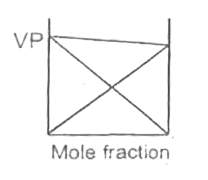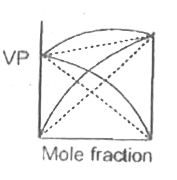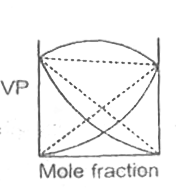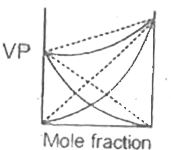An example of near ideal solution is:
n-heptane and n-hexane
CH3COOH+C5H5N
CHCl3+(C2H5)2O
H2O+HNO3
The correct Answer is:A
To determine an example of a near ideal solution, we need to understand the characteristics of ideal and non-ideal solutions, particularly in relation to Raoult's law.
1. Understanding Ideal Solutions:
- Ideal solutions are those that obey Raoult's law throughout the entire range of concentrations. This means that the vapor pressure of the solution is directly proportional to the mole fraction of the solvent.
2. Identifying Characteristics of Near Ideal Solutions:
- Near ideal solutions typically consist of components that have similar molecular structures. This similarity allows them to interact in a way that closely resembles the interactions in pure components.
3. Analyzing the Given Options:
- We need to evaluate the provided options to identify which pair of substances has similar molecular structures.
4. Evaluating Each Option:
- Option 1: n-heptane and n-hexane: Both are alkanes and have similar structures, differing only in the number of carbon atoms (7 for n-heptane and 6 for n-hexane). This similarity in structure suggests they are likely to form a near ideal solution.
- Option 2: Acetic Acid and C5H5N: These have different functional groups (carboxylic acid vs amine), indicating they are not similar enough to be considered near ideal.
- Option 3: Chloroform and C2H5-O: The presence of hydrogen bonding between these two compounds suggests strong interactions that deviate from ideal behavior, placing them in the non-ideal category.
- Option 4: Water and Nitric Acid: These two also have different structures and functional groups, leading to non-ideal behavior.
5. Conclusion:
- After evaluating the options, we find that n-heptane and n-hexane (Option 1) are the best example of a near ideal solution due to their similar alkane structures.
Final Answer:
The example of a near ideal solution is n-heptane and n-hexane.
- Ideal solutions are those that obey Raoult's law throughout the entire range of concentrations. This means that the vapor pressure of the solution is directly proportional to the mole fraction of the solvent.
- Near ideal solutions typically consist of components that have similar molecular structures. This similarity allows them to interact in a way that closely resembles the interactions in pure components.
- We need to evaluate the provided options to identify which pair of substances has similar molecular structures.
4. Evaluating Each Option:
- Option 1: n-heptane and n-hexane: Both are alkanes and have similar structures, differing only in the number of carbon atoms (7 for n-heptane and 6 for n-hexane). This similarity in structure suggests they are likely to form a near ideal solution.
- Option 2: Acetic Acid and C5H5N: These have different functional groups (carboxylic acid vs amine), indicating they are not similar enough to be considered near ideal.
- Option 3: Chloroform and C2H5-O: The presence of hydrogen bonding between these two compounds suggests strong interactions that deviate from ideal behavior, placing them in the non-ideal category.
- Option 4: Water and Nitric Acid: These two also have different structures and functional groups, leading to non-ideal behavior.
- After evaluating the options, we find that n-heptane and n-hexane (Option 1) are the best example of a near ideal solution due to their similar alkane structures.
The example of a near ideal solution is n-heptane and n-hexane.
Similar Questions
Knowledge Check
Which is not an example of an ideal solution ?
AC6H14+C7H16BH2O+C4H9OHCC2H5Br+C2H5IDCCl4+SiCl4For an ideal solution
AΔmixH=0,ΔmixV=0BΔmixV=0,ΔmixV≠0CΔmixH≠0,ΔmixV=0DΔmixH≠0,ΔmixV≠0IF C2H5OHandH2O solution is example of non-ideal solution then which graphically representation is correct?
A B
B C
C D
D
Explain with a suitable diagram and appropriate examples why some non-ideal solutions show postive deviation from ideal behaviour.
View SolutionConsider the following examples :
I. n~hexane + n~heptane
II. acetone + ethanol
III. bromoethane + chlorethane
IV. benzene + toluene
Which of the following combination is an example of ideal solutions?
View SolutionAn ideal solution is that which
View SolutionThe most likely on ideal solution is:
View SolutionAn example of a solution is
View Solution
